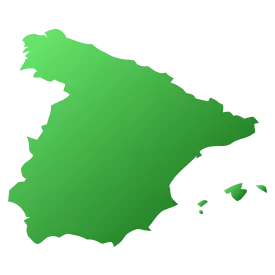Spain
Discover Spain
Fun Foods
Paella, Tapas, Patatas Bravas, Churros
Spain is located in southwestern Europe on the Iberian Peninsula. It is made up of 17 regions called autonomous communities, each with its own local traditions. Spain shares borders with Portugal and France and is an important country in Europe.
In ancient times, the area that is now Spain was inhabited by various groups, including the Iberians and Celts. Later, it became part of the Roman Empire, which left a lasting impact on Spanish language and culture. After the fall of Rome, different Germanic tribes, such as the Visigoths, ruled the land.
In the 8th century, Muslim Moors from North Africa conquered much of Spain. They controlled the region for several centuries, influencing Spanish architecture, science, and education. This period of Muslim rule left a rich cultural legacy that can still be seen today.
By the late 15th century, Christian kingdoms in northern Spain began pushing back the Moors. The kingdoms of Castile and Aragon united through the marriage of Ferdinand and Isabella, leading to the reconquest of Spain. In 1492, they completed the Reconquista by capturing Granada, the last Muslim stronghold.
The same year, Christopher Columbus, sponsored by Spain, discovered the Americas, paving the way for Spain to become a powerful empire. Over the next few centuries, Spain's empire expanded across the Americas and Asia, bringing wealth and influence.
In the 1800s and 1900s, Spain faced political instability and lost many of its colonies. The early 20th century saw the Spanish Civil War from 1936 to 1939, leading to the dictatorship of Francisco Franco. After Franco's death in 1975, Spain transitioned to a democracy and became a modern European nation.
Today, Spain is known for its vibrant culture, beautiful landscapes, and rich history. It is a member of the European Union and plays a significant role in international affairs. Spain's economy is diverse, with strengths in tourism, industry, and agriculture. However, like many countries, it faces challenges such as unemployment and regional independence movements.


Experience Points


XP EARNED OUT OF 0
Points Breakdown
| Sticker Collected | 0 XP |
| Card Collected | 0 XP |
| Bonuses | 0 XP |
| Total | 0 XP |
Your travel history

First Visit
---
Last Visit
---
You've logged 0 visits.
Sticker Collection

Barcelona
Founded as a Roman city, it has grown to the second largest city in Spain.

Cuenca
The Hanging Houses of Cuenca make for a beautiful photo opportunity.

Granada
Explore the iconic Alhambra Palace and the city's charming neighborhoods.

Madrid
With its 3.3 million residents, it's the 2nd largest city in the European Union.

Segovia
Its 1st century aqueduct and beautiful cathedral & castle make it a perfect day trip from Madrid.

Seville
Seville's role in the Spanish Empire's trade routes helped it grow in 16th century.

Toledo
The "City of Three Cultures" is a rich blend of Christian, Islamic, and Jewish history.

Alcazar of Segovia
Originally a Roman fort, the castle is one of the most recognizable in Spain due to it's unique shape.

Alcántara Bridge
Built in AD 104 to honor Roman Emperor Trajan.

Alhambra
Started in 1238, this Islamic palace complex was a self-contained city during the Nasrid era.

Amphitheatre of Tarraco
A 15,000 person entertainment venue built in the 2nd century.

Aqueduct of Segovia
This well preserved Roman aqueduct dates back to the 1st century AD.

Casa Vicens
A colorful, unique home build by Antoni Gaudi.

Circ Romà
A 325-meter track built for racing chariots.

Hanging Houses of Cuenca
These unique cliff-side houses are a UNESCO World Heritage Site.

Magic Fountain of Montjuïc
The fountain uses 3620 water jets to create an impressive visual display.

Palacio Real de Madrid
The Royal Palace of Madrid is the official home of the royal family although they do not live there.
.webp)
Park Guell
Designed by Antonio Gaudi, the park's unique design and beautiful city views are not to be missed.

Puente Nuevo
120-meter tall bridge connecting the city of Ronda

Roman Theatre of Mérida
Built between 16 and 15 BC by order of the Roman consul Marcus Vipsanius Agrippa.

Sagrada Familia
Still under construction, this unique basilica began development in 1882.

Segovia Cathedral
This large cathedral constructed in the 16th century was dedicated to the Virgin Mary.

Telefónica Building
Completed in 1930, it was the tallest building in Madrid until 1953.

Temple Expiatori del Sagrat Cor
Enjoy panoramic views of Barcelona from this church at the summit of Mount Tibidabo.

Temple of Diana
Made of granite, the temple was built in a classic Roman style.

